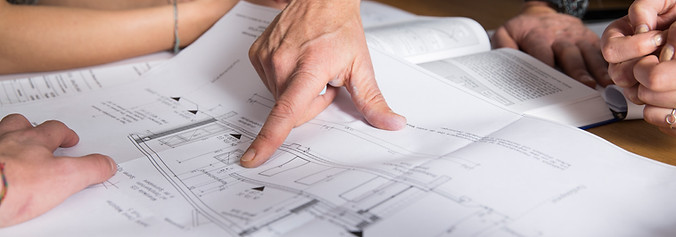

Our Process


List of Documents

Design Questionnaire

Reach out to us!
01
Site Analysis
(Understanding the Project Location & Conditions)
The foundation of any project starts with analyzing the site to gather crucial data that will impact design and construction. The key activities in this phase include:
-
Site Inventory: Documenting the physical and environmental aspects of the site.
-
SWOT Analysis: Identifying the strengths, weaknesses, opportunities, and threats related to the site.
-
Soil Test: Evaluating the ground conditions for construction suitability.
-
General Analysis: Assessing zoning regulations, accessibility, and other relevant factors.

02
Brainstorming
(Creative Concept Development)
In this phase, initial ideas and inspirations are explored to define the core theme of the project. Key aspects considered:
-
Stylisation: Determining the design aesthetics and visual appeal.
-
Room Typology: Deciding on different room categories and their functionality.
-
Points of Attraction: Identifying unique features to make the project appealing.
-
Landscape: Planning outdoor and green spaces.
-
Exterior Facades: Conceptualizing how the building will look externally.
-
Revenue Generation Ideas: Exploring business models and additional income streams.

03
Concept Finalization
(Defining the Project’s Key Elements)
At this stage, the rough ideas are converted into structured design concepts, categorized into three primary areas:
-
Landscaping: Drafting outdoor layouts, greenery, and open spaces.
-
Architecture: Defining building structure, spatial arrangement, and layout planning.
-
Interior Design: Establishing visual concepts, branding, furnishing, and accessories.
-
Visual Concepts: This step is about defining the visual identity of the project, ensuring that the aesthetics align with the intended design vision.
-
Brand Development: It involves establishing a unique identity for the project, ensuring consistency in branding and messaging.
-
Furnishing Choices: The selection of furniture and decor elements that complement the design.
-
Artefacts & Accessories: Finalizing decorative elements that enhance the overall ambiance and theme of the project.

04
Feasibility Study
( Testing the Viability of the Plan)
At this stage, variations in design are tested to determine the best options. This includes:
-
Variations in Landscaping, Options, Concepts, and Draft Plans
-
Planning, Positioning, Layouts, and Room Variations : This step ensures the project is practical and achievable before moving to the final design phase.
By testing different options, this phase ensures that the final design is optimized for functionality, efficiency, and cost-effectiveness.

05
Finalised Design Deliverables
( Preparation of Construction Documents & Branding)
Once the feasibility is confirmed, the final designs are prepared. Deliverables include:
-
Branding: The first deliverable includes branding elements, likely covering visual identity, logos, and marketing-related design components.
-
Brochure & Walkthrough: The second deliverable involves promotional materials such as brochures and digital walkthroughs (likely 3D or animated) to showcase the design.
-
Working Drawing: The third deliverable is the working drawing, which consists of detailed technical plans necessary for construction.
-
Detailed Design Components: The working drawing includes:
All Floor Plans – Layouts for different levels of the building.
Structural Drawings – Engineering details for the building’s structural integrity.
MEP Drawings – Mechanical, Electrical, and Plumbing drawings.
Detail Drawings – Specific intricate design elements.
Sections – Cross-sectional views of the design.
Elevations – Exterior views showing height and facade details.

06
Construction Phase
( Execution of the Project on Site)
This signifies the transition from design to actual construction, ensuring proper execution according to the finalized plans.
-
Stage-wise Delivery of Drawings: The construction process follows a phased approach where technical drawings are delivered progressively as needed. These may include foundation plans, structural details, electrical layouts, plumbing layouts, etc.
-
Site Visits for Technical Assistance: Engineers, architects, and designers visit the construction site to provide guidance and technical support. These visits ensure that the work aligns with the design intent, quality standards, and technical specifications.
-
Assistance in Material Procurement: Help is provided in selecting and procuring materials required for construction. Ensuring the right materials are used enhances quality, durability, and design integrity.
-
Components of Construction Phase: Each construction phase consists of different aspects, categorized as follows:
1. Interior Component
Focuses on the interior design aspects of the project. This Includes:
Furnishing – Selection of furniture and fittings.
Tiling – Choosing and installing floor and wall tiles.
Decor – Interior decoration elements like artwork, accessories, and themes.
Colour Palettes – Selection of colours for walls, ceilings, and interiors.
Fabric and Texture Consultancy – Guidance on selecting fabrics, textiles, and textures for furniture, curtains, etc.
Lighting – Designing and implementing interior lighting solutions. These Includes:
2. Building Component
Focuses on the external architectural elements. This Includes:
Exterior Facades – The external appearance and treatment of the building’s surface.
Cladding – Application of materials like stone, glass, wood, or metal to enhance the building’s exterior.
Lighting – Outdoor lighting solutions for aesthetics and functionality.
3. Landscape and Site Components
Focuses on external environmental and security aspects. Which includes:
Plants – Selection and placement of greenery to enhance aesthetics.
Procurement of Materials – Acquiring landscaping materials like stones, wood, soil, and irrigation systems.
Security – Implementation of security measures like CCTV, fencing, and access control.
Lighting – Outdoor and pathway lighting to ensure safety and ambiance.

